AMD’s 5 GHz Turbo CPU in Retail: The FX-9590 and ASRock 990FX Extreme9 Review
by Ian Cutress on August 9, 2014 8:00 AM ESTCPU Benchmarks: Comparing the AMD FX-9590
The dynamics of CPU Turbo modes, both Intel and AMD, can cause concern during environments with a variable threaded workload. There is also an added issue of the motherboard remaining consistent, depending on how the motherboard manufacturer wants to add in their own boosting technologies over the ones that Intel would prefer they used. In order to remain consistent, we implement an OS-level unique high performance mode on all the CPUs we test which should override any motherboard manufacturer performance mode.
It is worth noting that the FX-9590, against the A10-7850K for example, has double the threads and +1 GHz of core speed, despite the generational gap. Considering only these factors, the FX-9590 is most likely similar if not better at single threaded performance, but also 2x for multithreaded results.
HandBrake v0.9.9: link
For HandBrake, we take two videos (a 2h20 640x266 DVD rip and a 10min double UHD 3840x4320 animation short) and convert them to x264 format in an MP4 container. Results are given in terms of the frames per second processed, and HandBrake uses as many threads as possible.
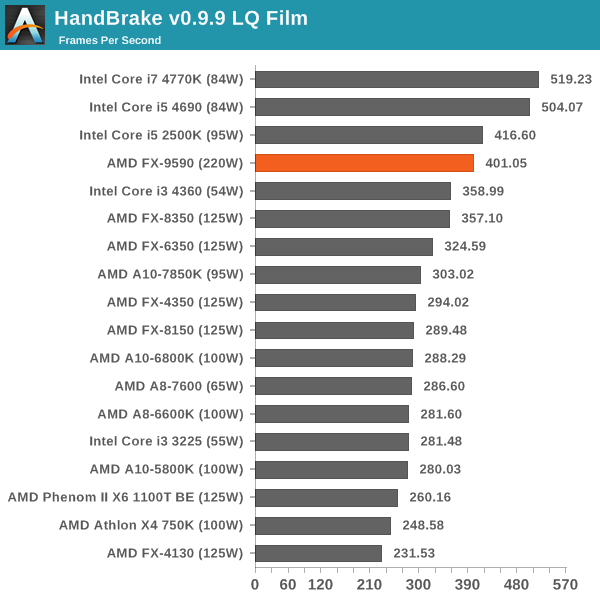
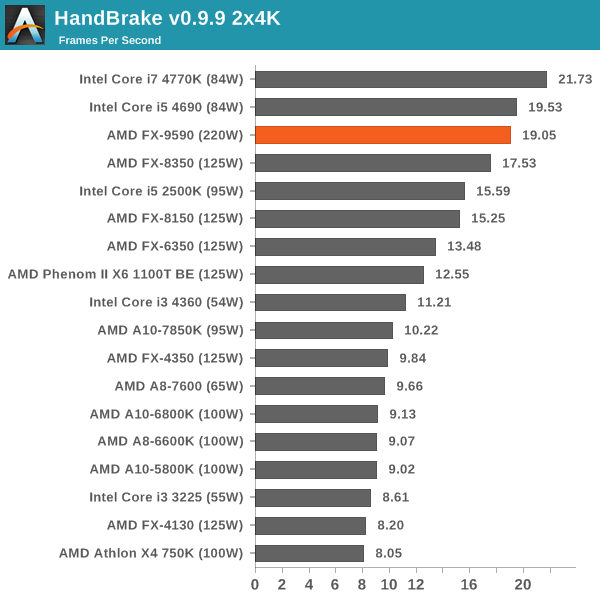
The eight threads of the FX-9590 give it almost another third of performance over the A10-7850K for small frame videos and nearly 2x for the larger frame conversion.
Agisoft Photoscan – 2D to 3D Image Manipulation: link
Agisoft Photoscan creates 3D models from 2D images, a process which is very computationally expensive. The algorithm is split into four distinct phases, and different phases of the model reconstruction require either fast memory, fast IPC, more cores, or even OpenCL compute devices to hand. Agisoft supplied us with a special version of the software to script the process, where we take 50 images of a stately home and convert it into a medium quality model. This benchmark typically takes around 15-20 minutes on a high end PC on the CPU alone, with GPUs reducing the time.
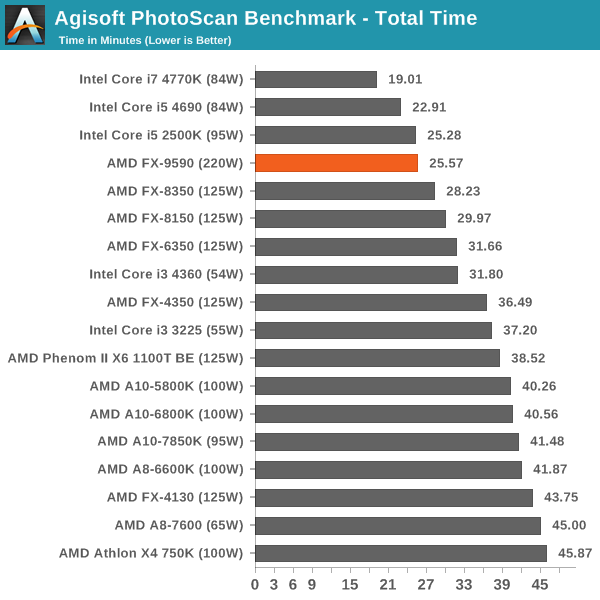
The FX-9590 puts in the best AMD CPU performance, similar to that of the i5-2500K.
Dolphin Benchmark: link
Many emulators are often bound by single thread CPU performance, and general reports tended to suggest that Haswell provided a significant boost to emulator performance. This benchmark runs a Wii program that raytraces a complex 3D scene inside the Dolphin Wii emulator. Performance on this benchmark is a good proxy of the speed of Dolphin CPU emulation, which is an intensive single core task using most aspects of a CPU. Results are given in minutes, where the Wii itself scores 17.53 minutes.
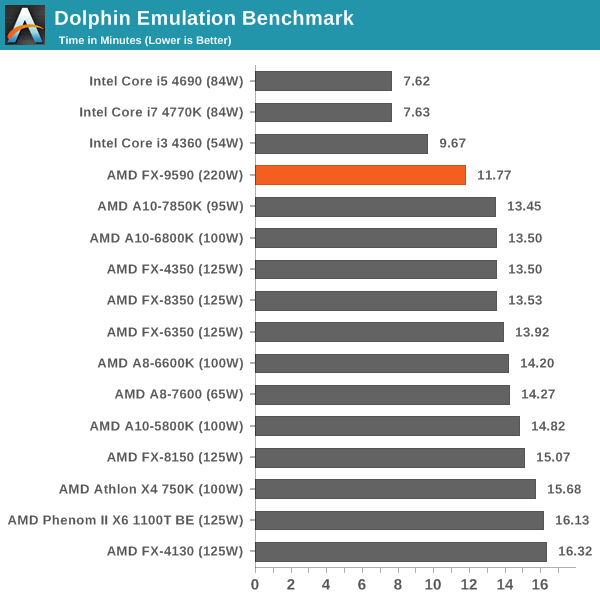
The FX-9590 beats almost everything pre-Haswell, showing the strength of a 5.0 GHz turbo mode. Note that it compares to the 3.5 GHz, 4MB L3 cache Haswell, which is 1.5 GHz slower and has half the L3.
WinRAR 5.0.1: link
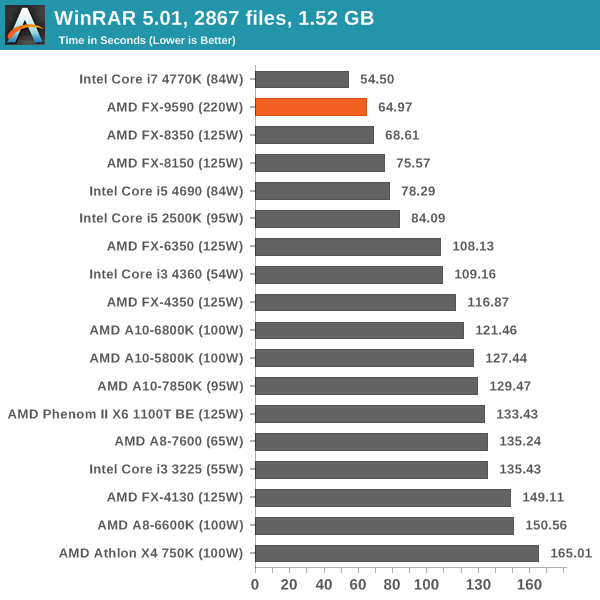
PCMark8 v2 OpenCL on R7 240
A new addition to our CPU testing suite is PCMark8 v2, where we test the Work 2.0 and Creative 3.0 suites in OpenCL mode.
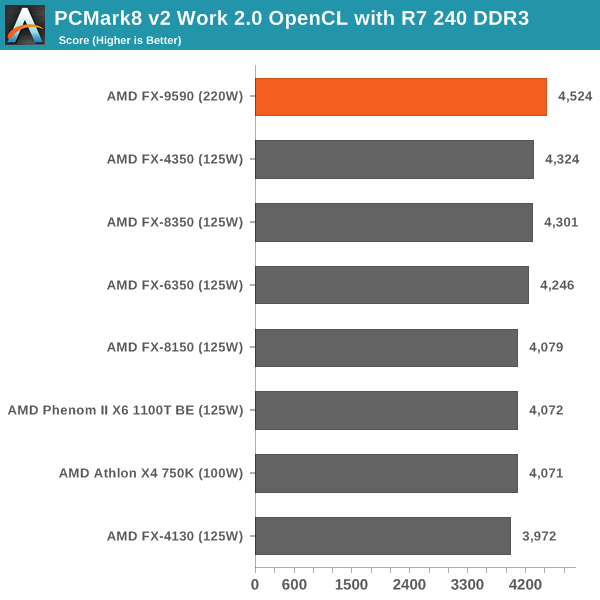
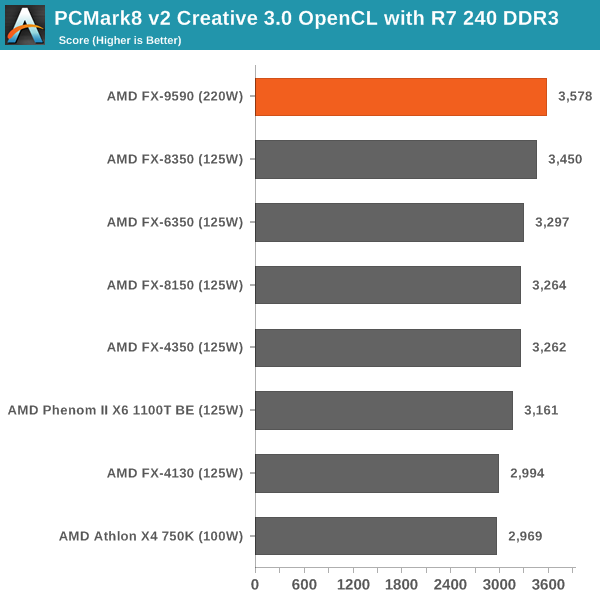
Hybrid x265
Hybrid is a new benchmark, where we take a 4K 1500 frame video and convert it into an x265 format without audio. Results are given in frames per second.
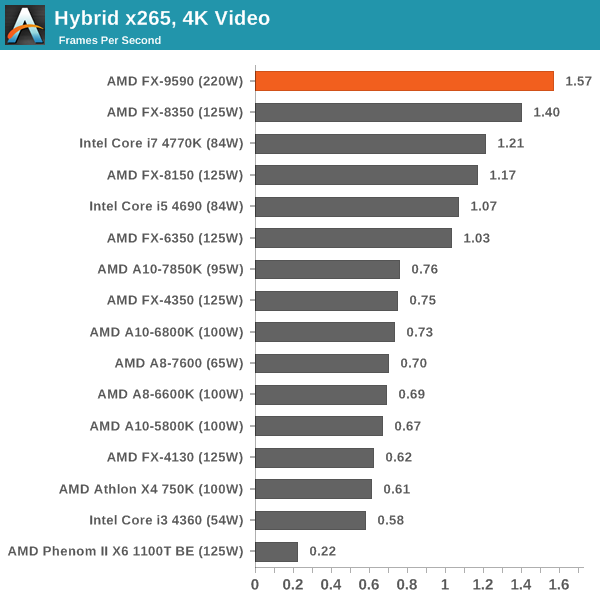
The FX-9590 holds up very well in the Hybrid x265 conversion, which makes me wonder how well an 8-thread Kaveri CPU would perform.
Cinebench R15
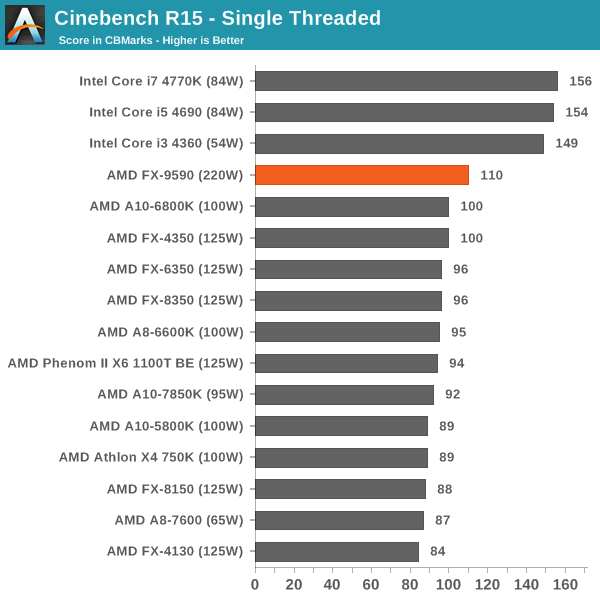
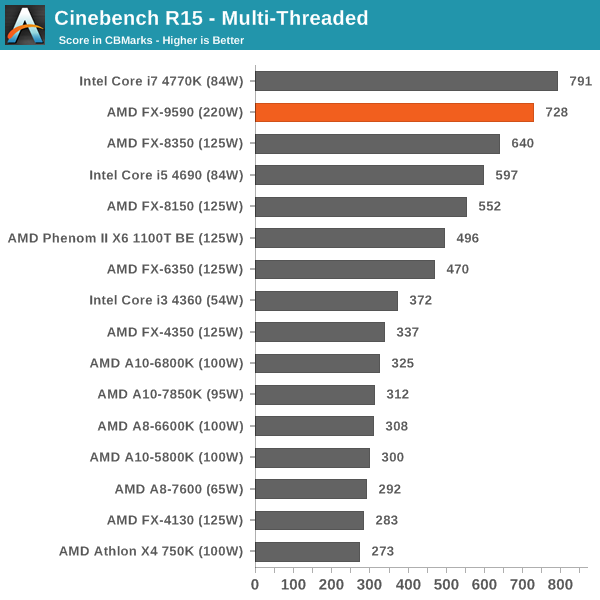
The FX-9590 still has the single thread edge over the newer AMD CPUs due to the high frequency, but is easily overtaken by the modern cheap Intel CPUs. For multithreaded competition, the 8 threads needs an 8 threaded Intel CPU to compete.
3D Particle Movement
3DPM is a self-penned benchmark, taking basic 3D movement algorithms used in Brownian Motion simulations and testing them for speed. High floating point performance, MHz and IPC wins in the single thread version, whereas the multithread version has to handle the threads and loves more cores.
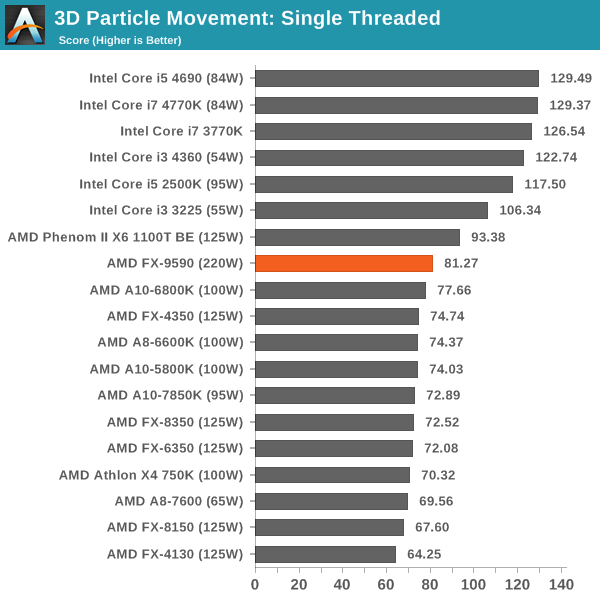
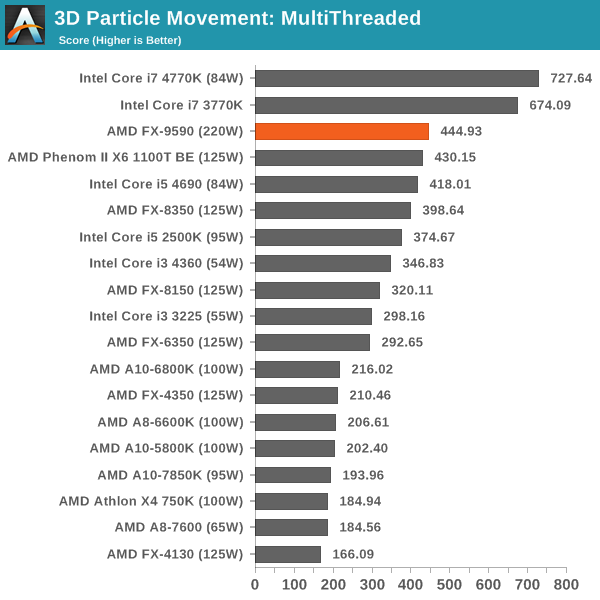
Although the FX-9590 again performs as the best AMD CPU, the floating point nature of the calculations in this test seems not to be favored by this architecture.
FastStone Image Viewer 4.9
FastStone is the program I use to perform quick or bulk actions on images, such as resizing, adjusting for color and cropping. In our test we take a series of 170 images in various sizes and formats and convert them all into 640x480 .gif files, maintaining the aspect ratio. FastStone does not use multithreading for this test, and results are given in seconds.

Similarly to 3DPM, for basic photo conversion any base 3.2 GHz Haswell CPU can outperform a 5.0 GHz AMD.










146 Comments
View All Comments
Sushisamurai - Saturday, August 9, 2014 - link
I think you guys are a little too harsh. The architecture was developed 2012-2013, so realistically, this is a sandy bridge/ivy bridge comparison. If you were to OC an ivy bridge/sandy bridge to this performance, you'd be looking at similar wattage (I'm guessing here, 5GHz on ivy/sandy doesn't seem possible on CLC). The fact it comes close to haswell for a year or two old part, I consider that a winDaniel Egger - Saturday, August 9, 2014 - link
Who cares when it was developed to do a comparison. They release it today so it has to compare against todays CPUs and this one sucks on so many levels it's not even funny anymore. Also no sane person cares about clock, it's either single- or multithread performance plus sometimes iGPU performance and of course efficiency, if you want crazy clocks you can dig out some Netburst Pentiums... Last but not least if you desperately want to see this PoC loose in some benchmarks against some mainstream Sandy Bridge CPU then have a look at the graphs and check for "Core i5-2500K".TiGr1982 - Saturday, August 9, 2014 - link
Indeed, clocks comparison does not work in terms of performance comparison between different microarchitectures.One simple number:
Haswell in single thread is around 70% faster (~1.7 times) than Piledriver (say, in Cinebench 1 thread) at the same clocks. ~70%. Check yourself. Nuff said.
Fouquin - Sunday, August 10, 2014 - link
Except they didn't release it today, they released it 14 months ago. So really, it's still an IB - FX comparison. AT was just really slow to put any press on this chips existence. It has no purpose other than to show the limit of the Bulldozer architecture, and it does that quite nicely. (Although I have an FX-8350 running at 5.12, so it isn't even the upper limits.)Really when it comes down to it though, it's a "for fun" chip. Like a super-car: it looks and acts fast, costs way too much, sucks down gas by the gallon, and is complete excess to your needs. But hey, it's shiny and looks good in the garage.
TiGr1982 - Saturday, August 9, 2014 - link
In fact, Sandy Bridge is much more efficient and has much higher IPC than Piledriver. So, Sandy Bridge i7 Core i7-2600K/2700K has to be overclocked around 4.3 GHz to match or surpass FX-9590. Ivy Bridge has slightly better IPC, than Sandy, so that 4.1-4.2 GHz should suffice for Ivy Bridge Core i7-3770K to match or surpass FX-9590. And this is for full multithreading.For single threading, Sandy and Ivy are already faster at stock turbo frequencies than anything Piledriver can offer. Piledriver has to be clocked beyond 6 GHz to try to match Core i7 stock single thread (LN2 may help, actually :)).
Yes, single-threaded performance is not so important these days, as many people like to point out, but lack of single-threaded performance is still a considerable drawback.
Sushisamurai - Saturday, August 9, 2014 - link
Yes, I realized clock to clock comparison doesn't really work - it would work if IPC was similar between different micro architectures... and well... I was over simplifying things. But, on the benchmarks, this FX core does seem to catch up to the i7-2500.My main point was to emphasize that this CPU has been around for a while, and was only recently "released" to the general public as opposed to OEM's. Had this been available when it was developed, it might have made a bigger difference for AMD - which could have potentially kept them in the CPU race.
TiGr1982 - Saturday, August 9, 2014 - link
Well, to make a bigger difference, it had to be WIDELY released a year ago (say, around initial Haswell release) for, say, $250-280 (and not $350) for retail, and be supported immediately with at least 5-7 new MOBOs capable of working with 220W TDP out of the box. Since it did not happen, now it is maybe "too little, too late" - especially, considering the facts, that:1) Devil's Canyon Core i7-4790K is already on sale, and it costs the same $$$ as last year's Core i7-4770K. Core i7-4790K is even further ahead of FX-9590 in terms of performance at stock (4.0-4.4 Ghz) and i7-4790K is even a little further overclockable to around 4.5-4.6 GHz with no issues, and FX-9590 is actually not.
2) Haswell-E is coming, and the cheapest Haswell-E, rumored to be Core i7-5820K, is supposed to have 6 Haswell cores and cost something around $400. This is of course worth thinking about for the people getting/building a new desktop machine.
mapesdhs - Tuesday, August 12, 2014 - link
Alas AFAIK the 5820K is a 4-core. 5930K is 6-core, 5960X is 8-core.
Ian.
TiGr1982 - Wednesday, August 13, 2014 - link
Not really; so far, all the sources point that Core i7-5820K will be 6 core - unlike Core i7-4820K and Core i7-3820 before it.mapesdhs - Tuesday, August 12, 2014 - link
SB is such a nice chip. Every 2700K I've obtained has happily run at 5GHz no problem,takes just a few minutes on a board like the ASUS M4E/Z. Built five of them so far. And
unlike the latest HW, it won't throttle because the temps are still good.
Ian.